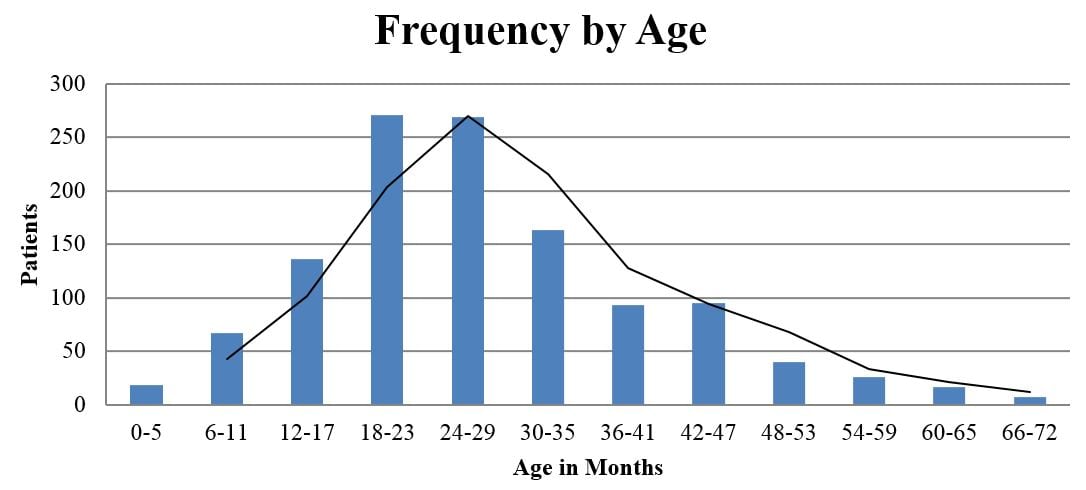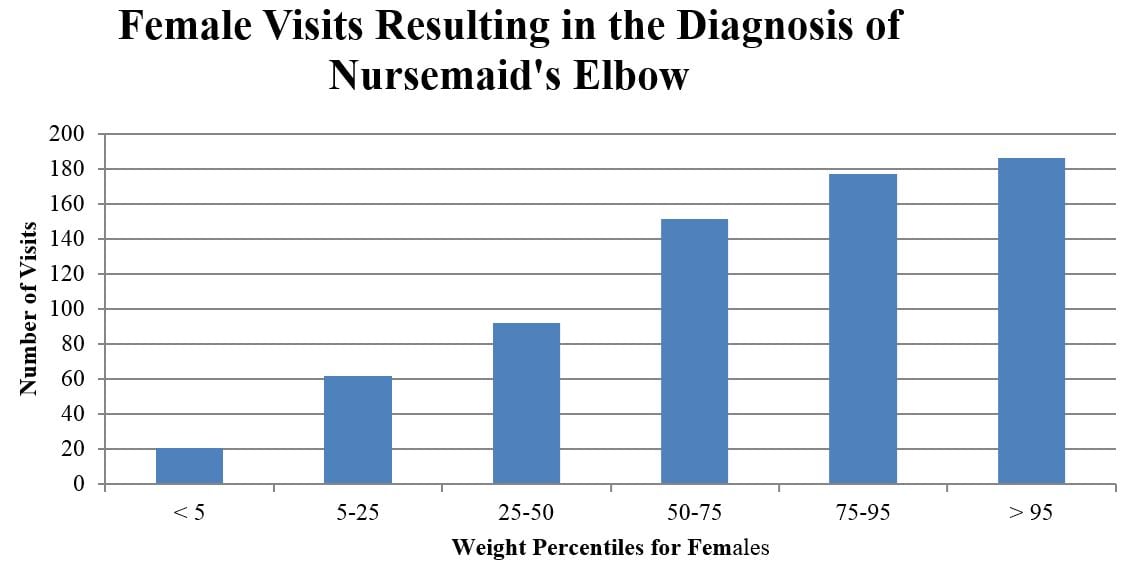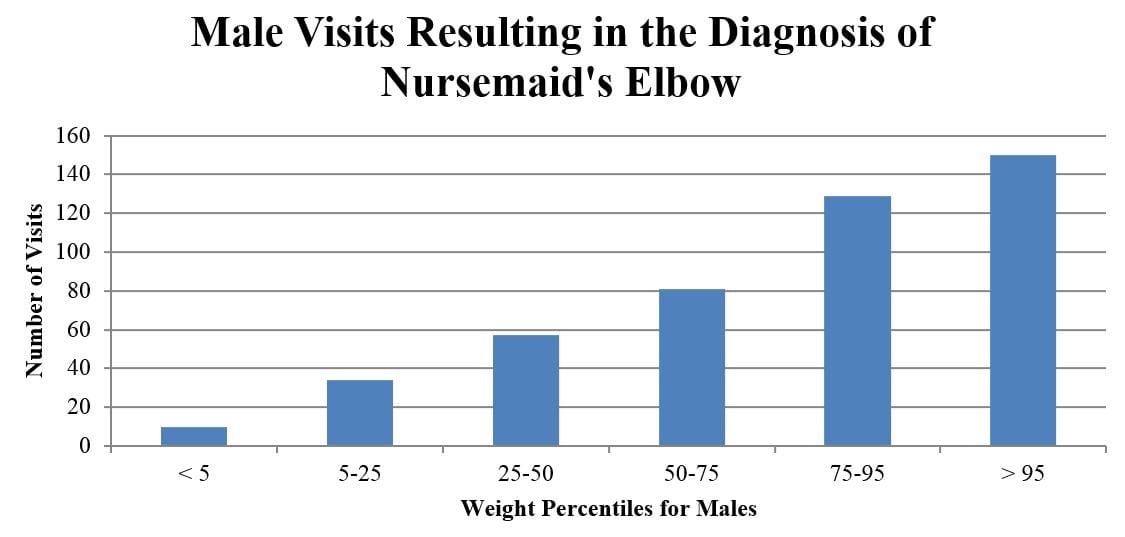| Author | Affiliation |
|---|---|
| Sarah Vitello, DO | Department of Emergency Medicine, Good Samaritan Hospital Medical Center, West Islip, New York |
| Ronald Dvorkin, MD | Department of Emergency Medicine, Good Samaritan Hospital Medical Center, West Islip, New York |
| Steven Sattler, DO | Department of Emergency Medicine, Good Samaritan Hospital Medical Center, West Islip, New York |
| David Levy, DO | Department of Emergency Medicine, Good Samaritan Hospital Medical Center, West Islip, New York |
| Lyncean Ung, DO | Department of Emergency Medicine, Good Samaritan Hospital Medical Center, West Islip, New York |
Introduction
Methods
Data/statistical analysis
Results
Discussion
Limitations
Conclusion
ABSTRACT
Introduction
To provide an epidemiological description of radial head subluxation, also known as nursemaid’s elbow, from a database of emergency department visits.
Methods
We conducted a retrospective medical record review of patients 6 years of age and younger, who presented to the ED between January 1, 2005, and December 31, 2012, and were diagnosed with nursemaid’s elbow. Inclusion criteria consisted of chart information, including date, unique account number, medical record number, weight, age, sex, and arm affected. Exclusion criteria included any charts with missing or incomplete data.
Results
There were 1,228 charts that met inclusion criteria. The majority of patients were female (60%). The mean age was 28.6 months (±12.6). The left arm was affected 60% of the time. Most of the included patients were over the 75th percentile for weight and more than one quarter were over the 95th percentile in each gender.
Conclusion
The average age of children presenting with nursemaid’s elbow was 28.6 months. Females were affected more than males, and the left arm was predominately affected. Most patients were above the 75th percentile for weight and more than one quarter were over the 95th percentile for weight. [West J Emerg Med. 2014;15(4):554–557.]
INTRODUCTION
Nursemaid’s elbow, also known as radial head subluxation, is a common pediatric condition that typically occurs in children between 1 and 4 years of age, with a slight predominance in females. Reports suggest that the left arm is affected more often than the right in both males and females, and associated with the usual history of a pull to the arm, such as when a child is suddenly picked up from the floor by their hand or pulled at the wrist to prevent a fall. Radial head subluxation occurs when axial traction is applied to an arm that is extended while the forearm is pronated, allowing for slippage of the head of the radius under the annular ligament.1,2 The distal attachment of the annular ligament covering the radial head is weaker and thinner in children as compared to adults, allowing it to be more easily torn or displaced.3 The condition is characterized by acute onset of pain in the elbow and inability to manipulate the arm at the elbow.3,4 The diagnosis is classically made by history and physical examination and confirmed by the patient using the affected arm after reduction. There are several techniques that may be employed for reduction, the most traditional being supination of the wrist followed by flexion at the elbow.2,5,6
Previous studies and reviews have identified epidemiological characteristics of nursemaid’s elbow while using smaller sample sizes and larger ranges for most affected ages;3,5 others have appraised various techniques for reduction of radial head subluxation.2,6,7
We wished to provide a larger epidemiological description of nursemaid’s elbow from a large database of emergency department (ED) visits retrospectively reviewed over a 7-year period.
METHODS
This was a retrospective electronic medical record review to determine the epidemiology of nursemaid’s elbow. We conducted the study at a suburban academic community hospital ED with an annual census of nearly 100,000 patients, of which 30,000 are pediatric patients (birth-21st birthday). This study has been approved by the hospital’s institutional review committee.
We conducted a search for all patients 0 to 6 years of age who had a final diagnosis of nursemaid’s elbow or subluxation of radial head, or the electronic medical record assigned the diagnosis code 832.2, between January 1, 2005, and December 31, 2012. We abstracted the following data points: date, unique account number, medical record number, weight, age, sex, and arm affected. Exclusion criteria included any charts with missing or incomplete data.
DATA/STATISTICAL ANALYSIS
We abstracted data from the electronic medical record (Allscripts ED™–formerly Healthmatics A4™). This computerized patient charting and order entry system enabled the collection of standardized information for each patient and integrated that information into a relational database. We queried the database by SQL Cognos Impromptu™ (Cognos) IBM (Armonk, New York), which allows the administrator to create reports using criteria filters. This has been described elsewhere.8,9 Using the inclusion criteria, we created a report with Cognos that queries all patients seen in the ED who fit the criteria for study enrollment. This report was further analyzed by Excel 2007 (Microsoft; Redmond, WA), using tools that Cognos does not possess.
RESULTS
There were a total of 1,228 visits to the ED with nursemaid’s elbow between January 1, 2005, and December 31, 2012. All 1,228 charts contained the queried information, except for 78 that did not record the patient’s weight. We included 1,150 charts in the weight analysis (Table 1).
Table 1. Characteristics of patients diagnosed with nursemaid’s elbow during 7-year study period.
| Characteristic N=1,228 | |
|---|---|
| Female visits | 59.7% (733) |
| Mean age (months) | 28.6 ±12.6 |
| Left arm | 59.8% (734) |
We grouped patients by age in 6-month intervals. The average age at diagnosis was 28.6 months ±12.6. Forty-four percent (540) of all children affected presented in the 18–29 month old period.
We broke down charts by month and gender, comparing patients’ weights to expected norms.10 For females, 363/689 (53%) were over the 75th percentile for weight and 186/689 (27%) were over the 95th percentile for weight. For males, 279/461 (61%) were over the 75th percentile for weight and 150–461 (33%) were over the 95th percentile for weight (Figures 1,2, and 3). One hundred thirty-seven patients presented to the ED multiple times, resulting in 177 additional visits, as shown in Table 2.
Figure 1. Age distribution of children with nursemaid’s elbow or radial head subluxation.
Figure 2. Distribution of affected females by weight.
Figure 3. Distribution of affected males by weight.
Table 2. Repeat patient encounters resulting in diagnosis of nursemaid’s elbow.
| Number of repeat ED visits by a patient | Number of patients |
|---|---|
| 7 (n=7) | 1 |
| 6 (n=6) | 1 |
| 5 (n=5) | 1 |
| 4 (n=16) | 4 |
| 3 (n=60) | 20 |
| 2 (n=220) | 110 |
| Total repeat visits = 314 | Total patients = 137 |
ED, emergency department.
DISCUSSION
As other studies have demonstrated, we also show a majority of patients with nursemaid’s elbow are female.4,5 As noted by Quan et al,5 it is not clear if this female predominance is related to behavioral differences of females versus males or to anatomic factors.
We also illustrate, as previous studies have found, the left arm is more frequently affected than the right. This is thought to be due to the fact that most adults are right handed and will likely hold the left hand of their child, thus predisposing that child to nursemaid’s elbow of the left arm.11
Our age distribution is consistent with that discussed in prior studies.2,4,5 After exploring case histories, Illingworth4 theorized that at the toddler age, 1–2 years, children are more prone to having the arm pulled by a parent.
Two other proposed theories to explain the age range when nursemaid’s elbow commonly occurs are the small size of the radial head in relation to the shaft and the fact that the annular ligament is thinner in children under the age of 5.3,4
Our study shows that nursemaid’s elbow is predominately a disease affecting children with elevated weight for age. The majority of patients were over the 75th percentile for weight, and over one quarter of all affected children were over the 95th percentile. Since 1980, the prevalence of obesity among children and adolescents has more than doubled.12 This is believed to be due to multiple different cause, including genetics and food preferences,13 increased TV viewing,14,15 fewer family meals together,15 gender, lower socioeconomic status and lower activity,16 and maternal employment.17 Our study demonstrates a relationship between overweight status and a physical condition, radial head subluxation, whereas other studies have demonstrated a psychosocial relationship between being obese or overweight and depressive symptoms, lower self-esteem,18,19 and social marginalization.20 Due to the numerous recognized consequences of elevated body weight and obesity, including radial head subluxation, emergency physicians should remain aware of their responsibility as physicians to promote increased physical activity and encourage healthy eating patterns among children presenting with radial head subluxation.
The data also show that about 1% of patient visits are repeat encounters, possibly due to predisposing factors previously mentioned, such as abnormal anatomy of the annular ligament or body weight.
Nursemaid’s elbow is a clinical diagnosis, and the treatments have a subjective endpoint. Having epidemiological characteristics of this disorder established will allow clinicians to feel more confident in diagnosing and treating the condition. After reviewing current studies, to the best of our knowledge, we believe this is the largest study to date, as well as the first report illustrating the clear association between nursemaid’s elbow and elevated body weight.
LIMITATIONS
This study was limited by its retrospective nature, as well as the fact that it was performed at a single suburban academic community hospital ED, which limits the applicability to other locales. Also, there may have been patients who had recurrences of radial head subluxation but were seen in a different medical facility for treatment.
In addition, there is a somewhat subjective nature in diagnosing nursemaid’s elbow. Most current literature on the subject describes sudden relief of pain and spontaneous movement of the affected arm as a confirmation of successful reduction and diagnosis, but it is up to the physician to determine what degree of movement constitutes successful reduction.4–6,11
In spite of these limitations, however, our study presents several features of interest. This study reviewed charts from a substantial period of time, and to our knowledge this is the largest epidemiological description of nursemaid’s elbow to date, as well as the first study to demonstrate a relationship between nursemaid’s elbow and elevated body weight.
CONCLUSION
Nursemaid’s elbow is a condition that affects mainly females, with left arm predominance, at an average age of 28.6 months. Most patient affected are above the 75th percentile for weight, and more than one quarter are over the 95th percentile for weight.
ACKNOWLEDGMENTS
We would like to thank Lindsay Hallas, Jeffrey W. Lawrence, Michaela A. Masciello, Siddharth Sheth, Nicole Sweeney, and Igor Lembersky for their help with data collection.
Footnotes
Full text available through open access at http://escholarship.org/uc/uciem_westjem
Address for Correspondence: Sarah Vitello, DO. Good Samaritan Hospital Medical Center, 1000 Montauk Hwy, West Islip, NY 11795. Email: warrensm@yahoo.com. 7 / 2014; 15:554 – 557
Submission history: Revision received September 17, 2013; Submitted December 31, 2013; Accepted January 27, 2014
Conflicts of Interest: By the WestJEM article submission agreement, all authors are required to disclose all affiliations, funding sources and financial or management relationships that could be perceived as potential sources of bias. The authors disclosed none.
REFERENCES
1. Griffin ME. Subluxation of the head of the radius in young children. Pediatrics. 1955;15j:103-106.
2. Macias CG, Bothner J, Wiebe R. A comparison of supination/flexion to hyperpronation in the reduction of radial head subluxations. Pediatrics Official J Amer Acad of Ped. 1998;102:e10.
3. Jongschaap HC, Youngson GG, Beattie TF. The epidemiology of radial head subluxation (‘Nursemaid’s Elbow’) in the Aberdeen City area. Health Bull (Edinb). 1990;48:58-61.
4. Illingworth CM. Pulled Elbow: A study of 100 patients. Br Med J. 1975;2:672-674.
5. Quan L, Marcuse EK. The epidemiology and treatment of radial head subluxation. Am J Dis Child. 1985;139:1194-1197.
6. McDonald J, Whitelaw C, Goldsmith LJ. Radial head subluxation: comparing two methods of reduction. Acad Emerg Med. 1999;6:715-718.
7. Green DA, Linares MY, Garcia Pena BM, et al. Randomized comparison of pain during radial head subluxation reduction using supination-flexion or forced pronation. Acad Emerg Med. 2006;22:235-239.
8. McGerald G, Dvorkin R, Levy D, Lovell-Rose S, Sharma A. Prescriptions for schedule II opioids and benzodiazepines increase after the introduction of computer-generated prescriptions. Acad Emerg Med. 2009;16:508-12.
9. Sharma AN, Dvorkin R, Tucker V, Margulies J, Yens D, Rosalia A. Medical reconciliation in patients discharged from the emergency department. J Emerg Med. 2011; article in press.
10. Centers for Disease Control and Prevention. CDC Web site. Available at: http://www.cdc.gov/growthcharts/charts.htm. May 2000. Accessed July 17, 2013.
11. Magill HK, Aitken AP. Nursemaid’s elbow. Surg Gynecol Obstet. 1954;98:753-756.
12. Ogden, C. Prevalence of obesity among children and adolescents: United States, trends 1963–1965 through 2007–2008. CDC Website. Available at: http://www.cdc.gov/nchs/data/hestat/obesity_child_07_08/obesity_child_07_08.htm. Accessed September 1, 2013.
13. Wardle J, Gurthrie C, Sanderson S, Birch L, Plomin R. Food and activity preferences in children of lean and obese parents. International J of Obesity. 2001;25:971-977.
14. Maffeis C Aetiology of overweight and obesity in children and adolescents. European J of Pediatrics. 2000; 159:S35-S44.
15. Gable S, Chang Y, Krull J. Television watching and frequency of family meals are predictive of overweight onset and persistence in a national sample of school-aged children. J of American Dietetic Assoc. 2007;107:53-61.
16. Danielzik S, Czerwinski-Mast M, Langnäse K. Parental overweight, socioeconomic status and high birth weight are the major determinants of overweight and obesity in 5–7 y-old children: baseline data of the Kiel Obesity Prevention Study (KOPS). International J of Obesity. 2004;28:1494-1502.
17. Anderson PM, Butcher KF, Levine PB. Maternal employment and overweight children. J of Health Economics. 2003;22:477-504.
18. Erickson S, Robinson T, Haydel K, Killen J. Are overweight children unhappy? Body mass index, depressive symptoms, and overweight concerns in elementary school children. Arch Ped Adolesc Med. 2000;154:931-935.
19. Strauss R. Childhood obesity and self-esteem. Pediatrics. 2000;105:e15.
20. Strauss RS, Pollack HA. Social marginalization of overweight children. Arch Ped Adolesc Med. 2003;157:746-752





